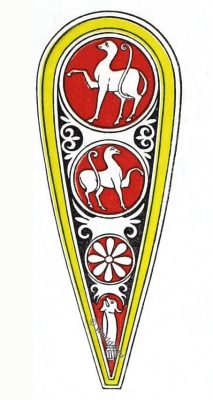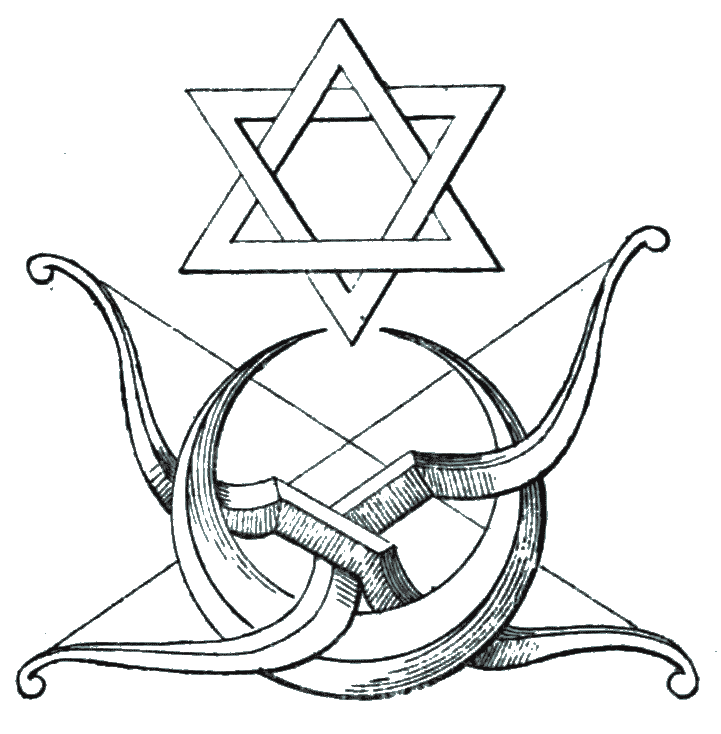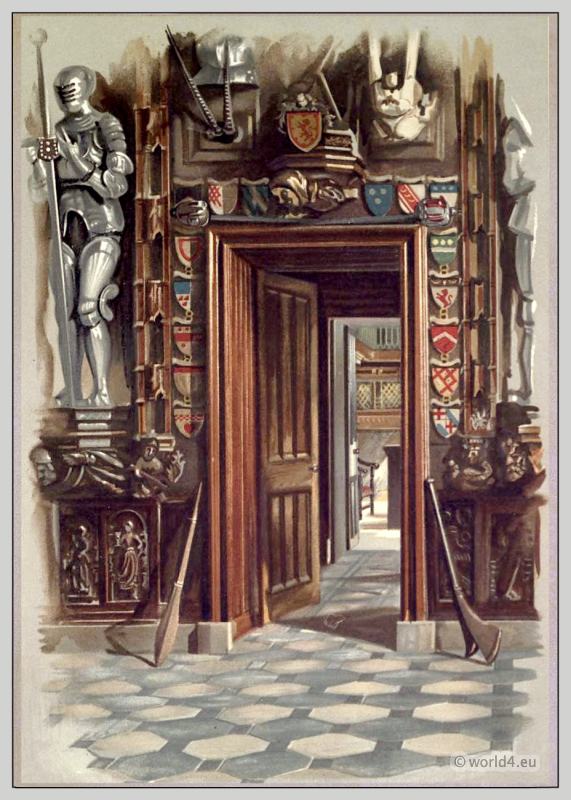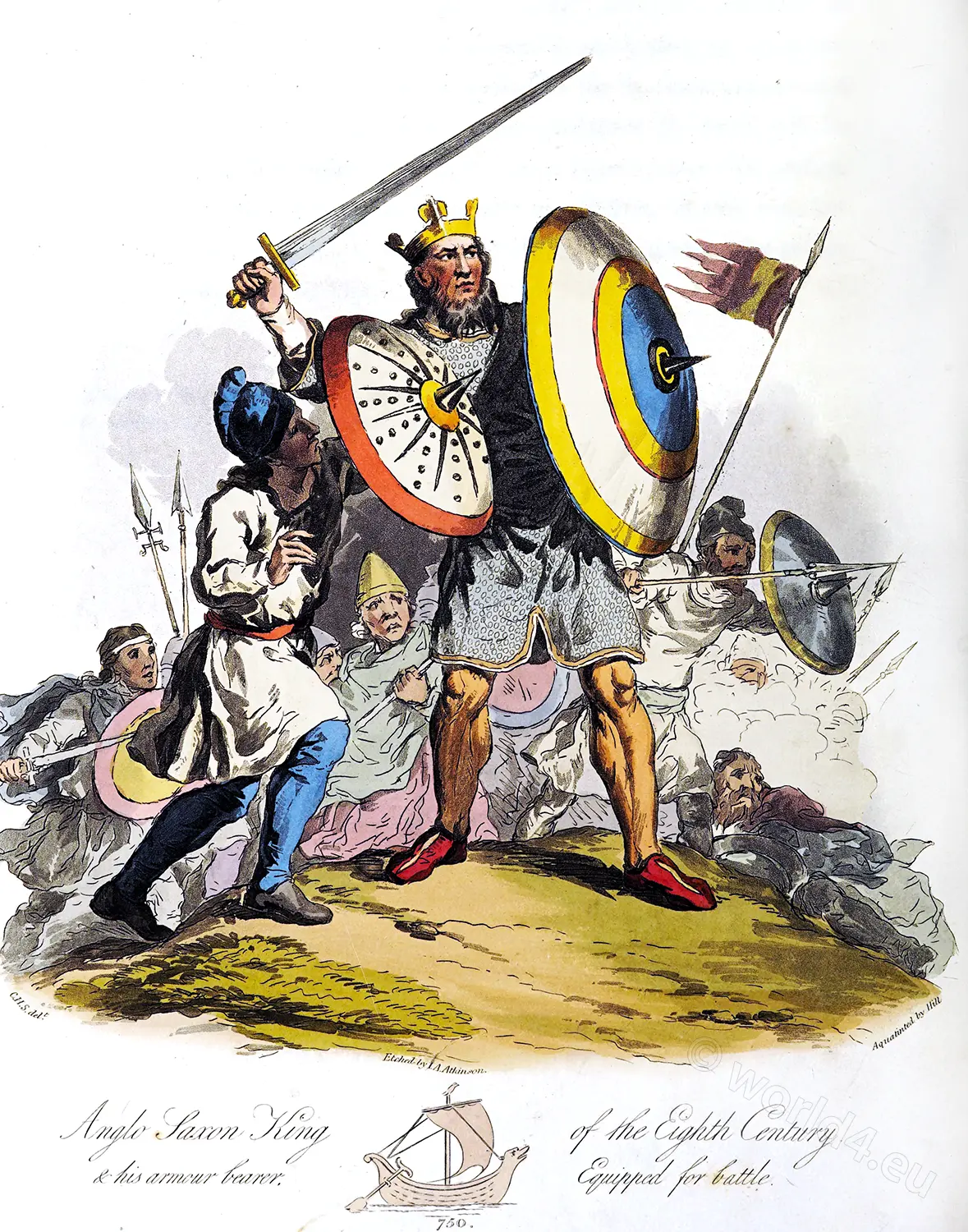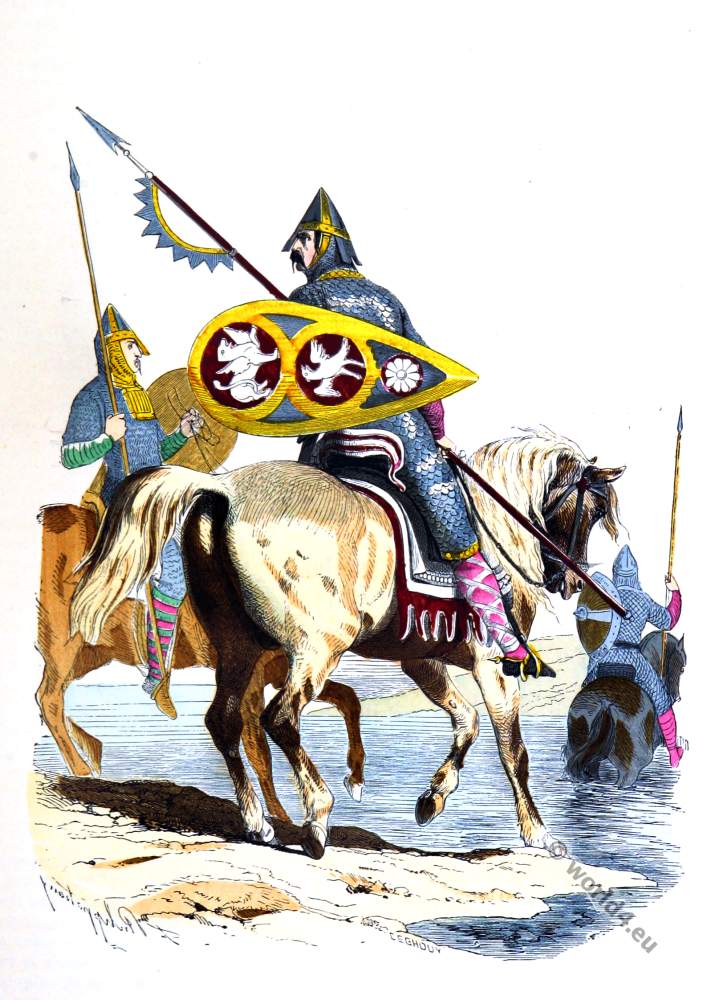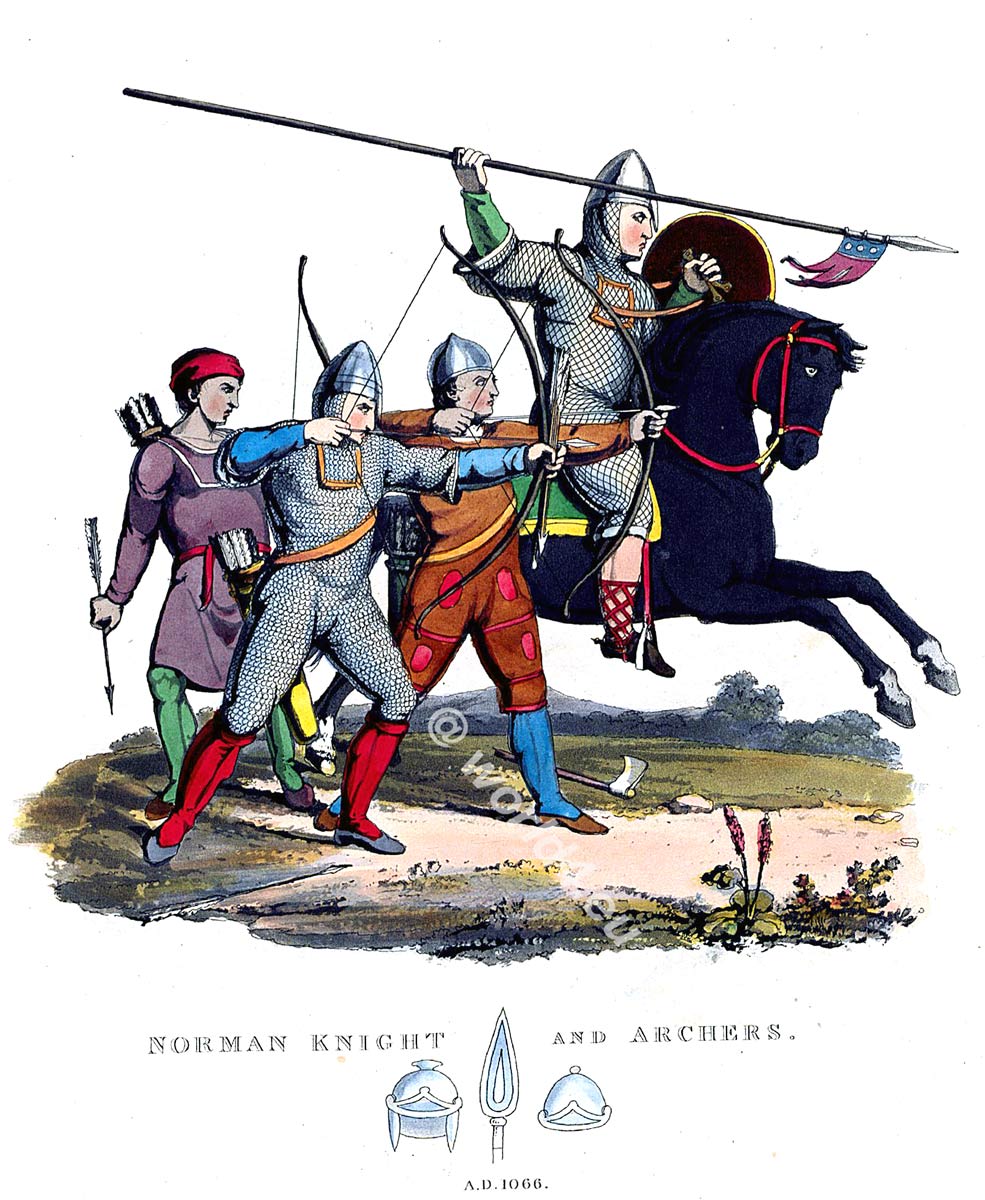
A CRITICAL INQUIRY INTO ANCIENT ARMOUR.
William the Conqueror.
1066.
SUCH had been the state of Armour in Britain when William led his army of Normans and Flemings to the victory at Hastings. His warriors had relaxed in no respect from the martial sentiments of their ancestors, but to their native courage added the improved science and discipline they had acquired from the Grecco-Romans.
In the age of Rollo, the founder of the Norman dukedom, the love of personal distinction and public admiration had been the great actuating principle. In order to attain glory, it was pursued by an assiduous cultivation of bodily strength, agility, and manual dexterity, combining, with the most. daring intrepidity, savage and warlike fortitude.*)
To hew well with the sword, to wrestle, to cast heavy weights, to run in skates, to sit firmly on horseback, to swim with vigor, to dart the lance with skill, and to manage dexterously the oar, were the Norman warriors’ boast. Vigor in archery was an emulation of excellence, and they proved their strength by sending a blunted spear through a raw bull’s hide. **)
Their wars with more polished competitors in some degree softened their ferocity, but in no respect affected their martial education .
*) Turner’s History of England, Vol. I.
**) Snorre, Vol. II, p. 19; and the Lodbrog Quida, or Death Song of Regnar Lodbrog.
In an examination into what was their armour at the time of their conquest of England, the engraving which purports to represent the seal of the Conqueror 1) is that to which our attention would be primarily directed. If this be authentic it may have been the work of a Greek artist, which, from the Norman intercourse with that country, is by no means improbable: the hehnet, indeed, which he wears, is in no respect like any other specimen of the time, but exactly resembles one on a Greece-Roman trophy, copied by Montfaucon. 2)
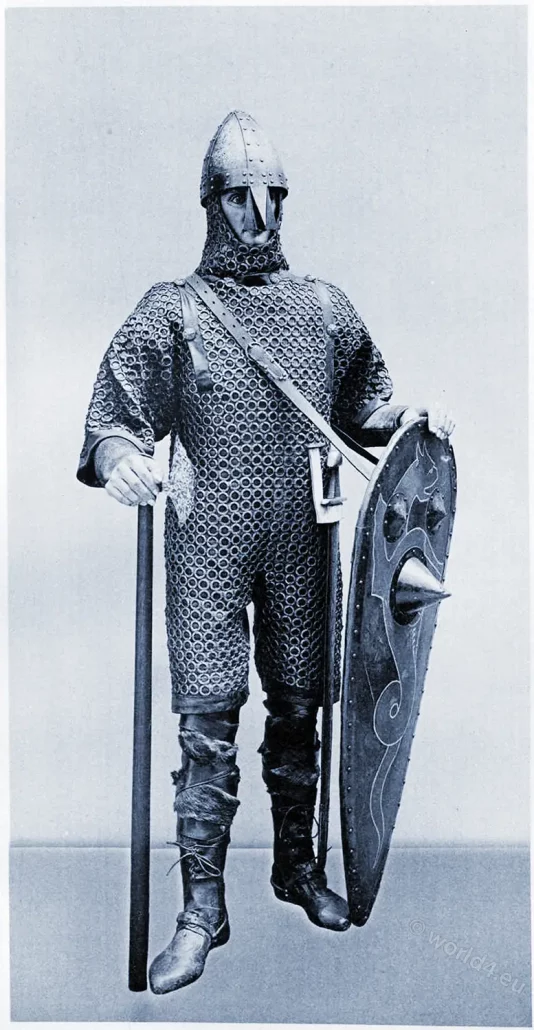

Description: Norman Knight from the second half of the 11th century
To afford ocular demonstration, they are both represented at the bottom of Plate VIII, that without the ear-pieces being taken from the seal. From this it will be further perceived, that it cannot represent his king-helmet.3) “which,” says the Saxon Chronicle, “he wore thrice every year when he was in England: at Easter he wore it at Winchester, on Pentecost at Westminster, and in mid-winter at Gloucester.”
The seal exhibits the king bare-legged, but booted, which was also perhaps a Greek fashion, and not adopted by the Anglo-Normans till the next century. He is in a hauberk apparently of rings set edgewise, which kind of armour had been used by the Anglo-Saxons: yet we learn from William of Poitou, and also from an anonymous author of the time, that, when he was preparing for the battle of Hastings, he accidentally inverted his hauberk, which is much more likely to have happened with one of rings or mascles sewn flat on the vesture, as in the Bayeux tapestry, than with the former projecting.
His lance with its gonfanon (from ital. gonfalone) is in his right hand. It differs from a banner in this respect: that, instead of being square and fastened to a transverse bar, the gonfanon, though of the same figure, was fixed in a frame made to turn like a modern ship’s-vane, with two or three streamers, or tails.
Notwithstanding this distinction the terms were often indiscriminately used, as will be found as we proceed. The object of the gonfanon was principally to render great people more conspicuous to their followers; and, secondly, to terrify the horses of their adversaries: hence the gonfanon became a mark of dignity, which is the cause of its being generally represented on the seals of our early kings. In the left hand of the Conqueror is his shield, but from the situation in which it is viewed its shape is not wholly defined.
The arguments of Mr. Stothard 4) seem to have placed it beyond a doubt, that the manufacture of the Bayeux tapestry is coeval with the reign of William the First.
1) See it in Sandford, Speed, &c. Whether the original wax impress still exists is not very certain, as this engraving itself has been copied for the new edition of the Foedera, while, generally speaking, the editors have had the seals re-engraved from the originals.
2) Antiq. expl. Sup. Tom. IV, Pl. XXV.
3) This was used instead of a crown, probably having some regal ornament in the Anglo-Saxon style. Abbot Suger, in his Life of Louis VI, says, that the head-dress of the Emperor Lothaire was composed of a mitre, surrounded at the top by a circle of gold in the form of a casque, beginning at the front and ending at the back part of the bead. 4) See Archreologia, Vol. XIX, p. 187.

To this source, therefore, we may freely recur for a correct representation of the armour of this period. It is of two kinds, leather and steel, with the conical nasal helmet: the former seems to be an improvement of the Anglo-Saxon; and the latter, in one of its forms, together with the helmet, to bear a strong resemblance to that of the Danes in the time of Canute.
The leather, which consists of a tunic with many overlapping flaps, has close sleeves which reach to the wrists, and was called corium and corietum. It is so termed in the Leges Normannicæ, 1) in the following passage: 2) Ad diem autem duelli assignatam, debent se pugiles in curia justiciario offerre antequam hora meridiei sit transacta, apparati in corietis vel tunicis consuetis, et cum scutis et baculis cornutis armati. “On the day appointed for the duel, the champions should present themselves in the court of justice before the hour of twelve o’clock, clad in corieta, or tunics, made of pieces sewn over each other, and armed with shields and cornuted staffs.”
This cornuted staff was the besague, or bisacutum, being double pointed like a pickaxe, with a short handle. Although it was subsequently much used, at the time of the conquest it was not considered a military weapon, but seems then to have been a double adze, and used by the carpenters. Thus, in the Roman de Rou, we read:
Li charpentiers qui empres vindrent
Grans coignies en leurs couls tindrent,
Dolouerres et besagues
Ourent à leur cotez pendues.
“The carpenters, who came on purpose,
Had great hatchets suspended from their necks;
Planes and double-adzes
Hung at their sides.”
Guillaume le Breton, in his Life of Philippe Auguste, calls this dress corium, for it continued till the time of Henry III.
Pectora tot coriis, tot gambesonibus armant.
“So many arm their breasts with coria, so many with gambesons.”
The steel armour consists of the flat rings placed contiguously, or the mascles; the former such as had been worn by the Saxons, the latter such as had been adopted by the Danes. It appears to have been extremely heavy, if we may judge from the following anecdote, recorded by William of Poitou, a cotemporary.
The Duke of Normandy, after landing at Hastings, went with twenty-five companions to explore the country, but so deep and rugged was the road, that William is praised for having burthen himself with the armour of one of the party, who was unable to reach the camp without putting it off.
1) Apud Ludewig.
2) On the trial by wager of battle.
The Saxons wore their armour either as a tunic or a cuirass; the Danes as a tunic, which hung over pantaloons, or, more technically speaking, chausses: but the Normans, as depicted in the tapestry, are, for the most part, habited in armour, which forms both breeches and jacket at the same time. This I take to be the haubergeon, as there are some few specimens of the tunic, or hauberk, and both being mentioned in the Roman de Rou.
This opinion is further strengthened by a specimen of this curiously shaped armour existing on a monument in Ireland as late as the time of Edward III. It appears to have been put on by first drawing it on the thighs, where it sits wide, and then putting the arms into the sleeves, which hang loosely, reaching not much below the elbow, as was the case with the Saxon flat-ringed tunic: the hood attached to it was then brought up over the head, and the opening on the chest covered by a square piece, through which were passed straps that fastened behind, hanging down with tasselled terminations, as did also the strap which drew the hood, or capuchon as it was called, tight round the forehead. This is evident in several figures in the tapestry, but the manner in which the armour was put on and fastened, is best shewn where William is arming Harold.
The Duke of Normandy is there represented as placing the helmet on the head of the Saxon earl with his left hand, while his right is busied making tight a strap, which is drawn through the rings on the breast of the latter. This circumstance is thus noticed by Robert Wace; 1) in his Roman de Rou, or History of Rollo and his Descendants:
Quant il fu au Duc communez
Qui a Aurences done estoit,
Et en Bretaigne aler vouloit,
La le fist le Duc chevalier
Armes et dras li fist baillier
A lui et a ses compaignons
Puis l’envoya sus les Bretons.
“When Harold was conducted to the Duke’s presence,
Who at that time was at Avranches,
And wished to go into Britanny,
The Duke created him in that place a knight:
Arms and clothing he caused to be distributed
To him and his companions,
And then sent him among the Bretons,”
No examples of such shaped armour in England occur previously, or in any subsequent reign; but it appears to have been introduced into Ireland, and worn in that country as late as the time of Edward III: nor does any distinguishing name seem to have been applied to it; hence, I conclude, that it is what Wace calls the haubergeon.
1) Wace’s father was at the battle of Hastings. Wace (* around 1110; † after 1174), also called Guace, Gaice (Southern Norman and French) and Robert Wace, was a Norman poet close to the court of the English King Henry II and his wife Eleonore of Aquitaine. The unfinished Roman de Rou, a story of the Dukes of Normandy, was commissioned around 1160 by King Henry II of England.
Describing the conduct and appearance, at the battle of Hastings, of Bishop Odo, the Conqueror’s half-brother, he says:
Forment y a ce jour valu
Un haubergeon avoit vestu
Desouz une chemise blanche
Lé en fu le cors et la manche,
Sor un cheval tout blanc seoit
Toute la gent le congnoissent
Un baston tenoit en son poing
Faisoit les chevaliers torner
Et la bataille arrester
Souvent les faisoit assaillir
Et souvent les fesoit ferir, &c.
“Acting on that memorable day,
A haubergeon had he put on.
Under a white frock,
Which covered his body and sleeve.
Seated on a milk-white steed,
Everyone recognized him.
He held a baton in his clenched hand;
He made the knights wheel about,
And the line to halt;
Often too he made them attack,
Often he made them strike,” &c.
The seal of this prelate is still extant, but the armour on it is not sufficiently distinct to warrant any conclusions. 1)
The Normans probably derived their armour from the Sicilians, as, when they first entered Apulia, a chieftain, who wished for their services, supplied them with arms; 2) and though they no doubt communicated it to the Danes, it does not occur in their delineations before the time of Canute. The Normans, however, had been constantly in the habit of sending for fresh succours from Denmark ever since their settlement in Normandy: these augmented their military population, and, by increasing their warlike energies, made them renowned for their splendid achievements. Wace, in his Metrical History of Normandy. 3) did not let this circumstance escape him. Speaking of Duke Richard, in 1030, he says:
Richart, ki volt sun dreit tenir
De Danemarche fist venir
Daneis, e bons combatturs
Ki lui firent si grant sucurs.
“Richard, who was determined to maintain his right.
Induced Danes to come from
Denmark, who were good warriors,
And who afforded him great succours.”
1) He is bare-headed, with a mantle at his back, a sword in his band, and pryck-spurs on his heels. See Archæologia, Vol. I, p. 386.
2) Gibbon’s Decline of the Roman Empire.
3) MS.in the Royal library, marked 4, c. 11.
The legs of the figures in the tapestry are, generally speaking, bound with bands of different colours, rising out of the shoe in the ancient Saxon manner; but in some instances, and where the hauberk is worn, they appear covered with mail to the ankles. Such, however, is the case only with the most distinguished characters, as William, Odo, Eustace, &c. This covering for the legs, according to William of Malmsbury (1080-1143), was called heuse, or hose; whence Robert of Normandy, being rather short-legged, we are told by Ordericus Vitalis, his contemporary, was often called by his father, Court-hose.
The Saxons are depicted as using their long javelins, battle-axes, and swords; while the principal weapon of the Normans is a lance, to which is sometimes attached the gonfanon, and sometimes the penon. These ensigns distinguished the rank of those who bore them, and are thus noticed by Wace:
Li barons ourent gonfanons
Li chevaliers ourent penons.
“The barons bad gonfanons,
The knights had penons.”
This last-mentioned was a simple streamer, of which the pennoncel, or pennonceau is the diminutive. It has been said, indeed, that it is owing to the right of the chief lords to carry the first kind of banner, when they joined their vassals to the armies of their kings, that they derived the title of baron; and that the knights, from their penons, for the same reason were termed bannerets. The bannerets, however, were those knights who were created on the field of battle, while the others were termed bas-chevaliers, inferior knights, corruptly bachelors.
But besides these, the commander-in-chief had a particular standard generally borne near his person, which was often alluded to under the word gonfanon. This standard occurs several times in the tapestry, but is invariably argent, a cross or, in a bordure azure; 1) but there is neither hint nor trace of the later invention of the Norman leopards. As this banner had been a present from the Pope, who had given the expedition his blessing, the colours were peculiarly applicable to its religious character.
1) See it represented in the initial letter of this reign.
The cross, perhaps, was gilt, to convey an idea of its splendour; and put on a white ground, to denote that it had been raised in purity: this, in that superstitious age, might have been contrived in the hope of exciting such an enthusiastic feeling as the revival of the miracle of Constantine: In hôc signo vinces, a relic, however, was added, to give greater efficacy. Thus, Wace observes:
L’Apostolle li ottria,
Un gonfanon li envoia
Moult precieux, et chier et bel
…………………….. anel.
Si, come it dit, dessus la pierre
Avoit un des cheveuls Saint Pierre.
“The Apostolic father worked for him overmuch,
And sent him a gonfanon,
Very precious, high-prized, and handsome.
……………………..
So, as he said, under the jewel
Was placed one of the hairs of St. Peter.”
The carrying of this standard was considered a high honour, and confided only to a trusty and valiant person of rank. The office, however, seems to have been at this early time hereditary, for the same author thus speaks of William:
Portez, dit-il, mon gonfanon
Ne vous veil faire le droit non
Par droit et par ancessorie
Devez estre de Normandie
Et vos parens gonfanongnier
Mont furent tint bon chevalier.
“Bear, said he. my gonfanon:
I could not deprive you of your due.
By right and by ancestry
You should be standard-bearer in Normandy:
And your parents, as gonfanoniers,
Were always accounted valiant knights.”
Acknowledging this right is a circumstance for which the knight thinks proper thus to thank him:
Grant merchi, dit-il
Que nostre droit recongnoissez ‘
Mes le gonfanon, par ma foy
Ne sera hui porté par moy.
“Many thanks, replied he,
For acknowledging our right:
But the gonfanon, by my faith,
Will not this day be borne by me.”
He then states his reasons for the refusal; upon which William-
Done apela un chevalier
Que mont avoit oi proisier
Toustainz Fiz-Rou le Blanc, ont nom
Au Bee au chans avoit maison;
Le gonfanon li a livrez
Et cil l’en a sceu bon crez
Volontiers la et bel et bien portez
Parfondment l’en a clinez.
“Then called a knight
Who had great prowess,
Toustainz Fitz-Rou the Fair was his name;
In the fields near Bee was his house;
To him he delivered the gonfanon,
And he knew how most suitably
To carry it willingly, well, and handsomely.
Bowing most profoundly.”
Harold had his standard also near his person, and on it, according to Malmsbury, was the figure of a man in combat, woven sumptuously with gold and jewels; though in the tapestry it appears charged with a dragon merely.
Heralt a l’estendart estoit
A son poer se deffendoit
Mez mout estoit de l’oeil grevez
Pour ceu qu’il li estoit crevez
A la douleur qu’il sentoit
Du cop de l’oeil qui li doloit
Vint un armé par la bataille
Heralt feri sor la ventaille
A terre le fist tresbuchier;
A ceu qu’il se vout condrecier
Un chevalier le rabati
Qui en la cuisse le feri
En la cuisse parmi le gros
La plaie fu disi qu’a l’os.
“Harold was at his standard;
He defended himself with all his might,
But much was he pained in the eye,
By that which for him was destruction
From the smart which be felt
At a blow in the eye which pained him,
For a weapon had come past his lines,
And struck Harold on his ventaille;
This made him tumble on the ground,
Though he would have recovered himself;
A knight beat him back, however,
Who struck him on the thigh,
On the fleshy part of the thigh,
The wound was made down to the bone.”
By the ventaille is here meant merely the open part below his helmet, and in front of his hood, by which he received the air. The ventaculum, or ventaille, strictly speaking, was not at this time invented, but was in full use when Wace lived: he adopts it, therefore, merely for the sake of the rhyme, and as familiar to his countrymen.
The other weapons used by the Normans are maces and long cutting swords, bows and arrows, their main body appearing to be flanked by archers. All those circumstances are noticed in the Roman de Rou. Thus, in describing the preparations for assembling the army, the author tells us, that William:
Par la contree fist mander.
Et as vilains dire et crier
Que o tiex annes com il ont
Viengnent à luy ains qu’il porront
Lors voissiez haster vilains
Pilx et Machues en lor mains.
“Throughout tho country sent his orders,
To call upon and proclaim to the villains,
That with their arms, such as they bad,
They should come to him as speedily as possible:
Then you might have seen the villains hastening
With piles and maces in their hands.”
And afterwards, recounting the battle, he exclaims:
La voissiez fiere assemblée
Maint coup de lance, et maint d’épée
Des lances fierent chevaliers,
Et o les arz traient archiers
Et o les pilz vilains lour donnent.
“There you might have seen a proud assemblage,
Many thrusts of lances, and many cuts of swords;
Of lances made by the knights,
And shots from the bows drawn by the archers,
And blows from the piles given by the villains.”
The pilx et machues were clubs and maces; pil, or pile, being a piece of wood cut smaller at one end than the other, resembling the Irish shillelah: 1) the machue was something of the same kind, but with a large head. A superior one, probably of iron, appears in the hand of Odo, in the tapestry, and some other equestrian figures, 2) but its adoption by the knights generally was later than the Conquest.
The piles and maces were the weapons of the serfs, who were not permitted to make use of the lance and sword, 3) which, in the Conqueror’s laws, 4) are expressly called arma libera, “the arms of freemen.”
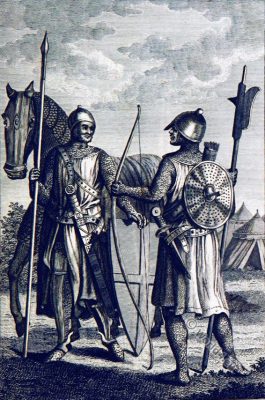
The archers appear variously habited, some with their quivers at the left hip, and others at the left shoulder. The bow as a weapon of war was certainly introduced by the Normans; the Saxons, like the people of Taheite (Tahiti) at the present day, using it merely for killing birds.
On this account, in the speech which Henry of Huntingdon puts into the Conqueror’s mouth before the battle, he makes him stigmatize the Saxons as “a nation not even having arrows.” William himself was skilful in archery; and such was his strength, according to Malmsbury, that no one could bend his bow: and others affirm, that, sitting on horseback, he could draw the string of a bow which no other man could bend even on foot.
1) It is used as a charge in heraldry, and is there depicted as an inverted obelisk.
2) It seems to have been derived from the Græco-Romans in Italy, where ancient heads of maces are frequently dug up.
3) The sword was attached by a small belt too short to form a girdle, as may be seen in the initial letter of this reign.
4) Cap. Ixv, de Manumissione Servorum.
As Harold fell by an arrow, and the firm phalanx of the Saxons was chiefly broken by this weapon, the bow ever after became a favorite weapon in England. The laws of the Conqueror do not rank it, however, among the arms of a nobleman. All that are required are the following: De relief al cunte, que al rei afeist: “VIII chivalz selez e enfrenez, les IIII halbers, et IIII hammes et IIII escuz et IIII lances et IIII espes”. “Of the assistance which a count must bring to the king-eight horses saddled and bridled, four hauberks, and four helmets, four shields, four lances, and four swords.” This ordinance would mount and equip four knights, and leave four spare horses for light cavalry, for sumpter horses, or to supply the place of such a might be killed. The archers in the tapestry are habited in haubergeons, as it were, of cloth, or in tunics: one appears in the same armour as the cavalry, from which it may probably be inferred, that he is a knight, or son of some rich baron.
Plate VIII represents the different costumes of the archers and that of a knight on horseback. The mounted figure is in the mascled, and one of the bowmen in the flat-ringed armour.
The Normans placed their chief reliance on their cavalry, while the Saxons depended on the compact masses of their infantry. Normandy indeed furnished, as it still does, most excellent spirited little horses, capable of great fatigue; but William, we are told, preferred the Spanish breed. Thus, on the eve of battle:
Son bon cheval fist demander
No peust l’en meilleur trouver
Des Espaigne li ont envée
Un roi par moult grant amistié
Armes ne presses ne doubtast
Se si sires n’esperounast
Gautier Giffart lour amené
Qui a Saint Jame avoit este.
“He gave orders for his good horse,
A better than which could not be found.
From Spain had it been sent
By a king, who had for him the greatest friendship:
It feared neither arms nor the press of battle,
Hits riders merely spurred it.
Walter Giffard brought it with him,
Who had been at Sant Jago.”
From this description it appears to have been an Arabian, or a cross from one. Indeed, we know that breed was in high esteem with the Normans, as Robert Duke of Gloucester, in Stephen’s reign, first improved the English horse by the importations of Arabians, with which he stocked his park at Powis Castle.
Not only did the Normans pay attention to their cavalry, but they introduced the art of shoeing horses, as at present practiced, into England; for though the Britons had been taught the use of them by the Romans, their pedolau were probably considered too clumsy to be adopted by the Saxons. The Roman horse-shoe, or pedillum, lapped over, and was tied round the hoof of the horse, and, therefore, occasioned a rattling sound. 1) All the horses in the tapestry appear shod, but the want of correct drawing in this respect will not allow us thence to determine, whether they were in the Roman or modern fashion.
Henry de Ferrers, or de Ferrariis, 2) who accompanied the Conqueror, took his name, it seems, from having been appointed to superintend the shoeing of the horses, as præfectus fabrorum, a circumstance which his posterity commemorated in their armorial bearings. William also gave to Simon St. Liz the town of Northampton, with the hundred of Falkley, then valued at £40 per annum, on condition of providing shoes for his horse.
We see the infancy of the art in the great value put on the production; and, indeed, so late as the time of Edward I, the rarity of horse-shoes is evident from their being demanded besides the horse. Thus, in the Plac. Cor. 13, Edw. I, we read: Henricus de Averyng tenuit manerium de Morton in com. Essex in capite de dom; rege per serjantium inveniendi unum hominem cum uno equo precii x s. et quatuor ferris e quorum, et uno sacco de coreo, et una brochea ferrea, quotiescunque contigerit dominum regem ire in Walliam cum exercitu sumptibus suis propriis per quadraginta dies. “Henry de Averyng held the manor of Morton, in the county of Essex, in capite of our lord the king, by the sergeantry of finding a man with a horse, value ten shillings, and four horse-shoes, one sack of barley, and one iron buckle, as often as it may happen that our lord the king should go with his army into Wales, at his own proper expense, for forty days.”
The Franks in the ninth century used only to shoe their horses in winter, and it is probable that the Normans, in like manner, did not keep their steeds constantly shod. That the mode of fastening the shoes in France was, however, with nails, we learn from the discovery of one which belonged to the horse of Childeric, and was found, with many other things, in his grave. This would intimate, that the practice had been continued for about five centuries before the landing of the Normans in England.
The saddles, too, are worthy of remark, being somewhat in the Asiatic style, rising very high before and behind, so as to form curves, differing in this respect from those of the Saxons, which seem to have been little more than a cushion on the horse. The high bow of the saddle occasioned the Conqueror’s death; for having
1) See the subject amply discussed in the Archæologia, Vol. III. I have seen one of this kind of horse-shoe, which was found, about eight years ago, at Ambleside, in Cumberland, together with a Roman sword.
2) Henri de Ferrières (died between 1093 and 1100) Lord of Tutbury in England and Lord of Ferrières in the Duchy of Normandy, was an important Anglo-Norman administrator and baron. He was the founder of the Anglo-Norman family Ferrers.
burnt the town of Mante, while directing his troops where to spread the conflagration, his horse stepped on some hot ashes, suddenly plunged, and he, having become very corpulent, was struck on the belly; this produced a rupture or an inflammation, which, from the heat of the season and of the fire, was followed by a fever that soon exhibited mortal appearances.1)
The Norman spurs differed but little from those of the Franks and Saxons: the neck was rather shorter, the pyramidal head rather concave on every side, which afterwards suggested the ring and spike of the pryck-spur, and the shanks, instead of being straight, curved. 2)
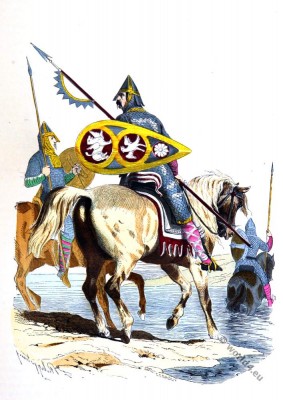
The shield; as depicted in the tapestry 3) and introduced by the Normans, was of a very peculiar form. It has been called heater-shield and kite-shield by modern antiquaries, from its supposed resemblance to those familiar objects, but by the Normans themselves it was merely termed escu, from the Latin scutum. It appears to have been derived, as well as its name, from the Romans, the Danish origin of the Normans seeming to imply that their more ancient shield was lunated. This supposition is countenanced by two figures, intended to represent Roulant and Olivier, the paladins of Charlemagne, sculptured on the cathedral church of Verona, which, from other details of costume, there is reason to conclude are rather older than the Conquest.4)
Their shields, however, are not quite so round at top as the Norman. Livy says, that “the shield used by the Samnites was long, and at the lower part cut off towards an acute point.” This did not, however, resemble the Norman shield, nor have we any thing to show that it was retained by the Romans after the days of that historian.
In Montfaucon’s Antiq. expl. is a representation of Perseus, with his armour lying by him. It appears to be Etruscan; and if the angles of the shield were rounded off we should exactly have the form of the Norman one, though not so large. This leads us to the Greeks 5) and we find in Sir Wm. Hamilton’s collection of Greek and Etruscan vases,6) one on which is painted the rape of Cassandra, from the temple of Pallas.
1) Malms. 112; Ord. Vit, 656; and Wace.
2) Original specimens of both kinds are in the armoury of Llewelyn Meyrick, Esq.
3) See it represented in the initial letter of this reign.
4) See an engraving of them in Maffei’s Verona Illustrata. One of them has only one leg covered with armour, and wears a hauberk; the other is without any body-armour. There is however, one circumstance which seems to militate against the date I have assigned to them, viz., that Olivier is represented cross-legged: but it is still a question whether that custom originated with the crusades; or, if appropriated to the champions in holy wars, whether that of Charlemagne against the Mohammedans may not come under this denomination.
5)And yet the later Greeks of Constantinople were quite unacquainted with them, for Cinnamus informs us, that the Emperor Manuel Comnenus, on his succession to the throne, taught his people a new mode of fighting, ordering them in future to use long shields instead of round ones, and to learn the management of long lances like the French.
6) Neapolitan edition, Vol. III, Pl. LVII.
The companion of Ajax is here represented with one of these heater-shields, but as the top is obscured by the position in which it is held, whether it was curved or straight there are no means to determine. This, however, is the only instance in those four large folio volumes that contain the collection. It appears to have been the original pelta, and if so it would necessarily be rounded at top, for, according to Xenophon, that was in the form of an ivy-leaf, and first used by the Amazons. Thus, like every part of early armour, we find it had an Asiatic origin.
From two Sicilian bronzes, in the museum of Llewelyn Meyrick, Esq., it appears that the kite-shaped shields were used by the inhabitants of the kingdoms of Naples and Sicily, and had, therefore, been retained from their ancestors, the Greek colonists. Now fifty years before the conquest of England the Normans had penetrated those territories; and Melo, the chief of Bari, according to Gibbon, furnished many of them with arms and horses: thirteen years after they founded the city of Aversa, and in about a dozen more they conquered Apulia.
The constant intercourse between the Normans in France and their brethren in Italy and Sicily will account for the adoption of similar weapons, whether offensive or defensive. In the tapestry the shields appear to have been at least four feet in length, and not quite two in their greatest breadth. Upon them are seen various devices, but none which may properly be termed heraldic: on no one can a lion, fess, chevron, or other charge of blazonry be found; all that appear are dragons, crosses, and spots: nor do we perceive any particular or distinguished individual twice bearing the same device.
The gonfanons and penons attached to the lances are similarly ornamented, with this exception only, that they bear no animals. On a shield held by a Sicilian bronze figure, engraved in Montfaucon’s Antiq. expl. Tom. IV, Pl. XV, precisely like one of those with the kite-shaped shield already noticed, is a griffin, which seems to indicate that the Normans not only borrowed the form, but also the monsters, for decoration, from the same source.
While in the tapestry most of the Saxon shields are represented round or oval, with a central boss, as in the illuminations of that people, there is no instance of a Norman with any other than the long kite-shaped one just described.
It was the custom at this period, when a town or castle surrendered, for the principal person to bring and present to the conqueror the keys on the point of a spear. This is depicted in the Bayeux tapestry; and Hollinshed informs us, that when Malcolme, king of Scotland, besieged the castle of Alnwicke, and had reduced the garrison to the last necessity, a young knight, willing to undertake some hardy enterprize in its defense, took a swift horse, and without armour or weapon except a spear in his hand, upon the point of which he bore the keys of the castle, rode into the camp of the enemy, who, supposing he came to surrender them, received him with joy, and unsuspectingly led him to the king.
The knight then couched his spear, as if he intended with reverence, to present to him the keys, but, watching his opportunity, he urged on his horse, and ran the point into the eye of the king, killing him on the spot: that done he clapped spurs to his horse, and by his swift flight saved his own life.1)
With respect to fortifications, the Normans, Saxons, and Welsh used often in cases of necessity to erect forts of wood for immediate use. Verstegan informs us, that William the Conqueror, on his first arrival in England, set up “three castles of wood, which had been made and framed in Normandy,” and from thence brought over with him: and Matthew Paris says, that the Saxon warrior Hereward, when he withstood the Conqueror, being in the fenny parts of Cambridgeshire, where he intended to winter, constructed a castle of wood.
But we are not from this to draw our conclusions respecting the military architecture of the Normans: Canterbury, Rochester, Lincoln, Tickell Castle, and others, with Clifford’s Tower at York, evince superior skill in the art of defense and masonry during the reign of William the Conqueror. It does not come within the limits of this work to enter into an investigation of this subject, therefore it will be sufficient to notice, that the most ancient part of Launceston Castle, in Cornwall, affords a clue to the British mode of fortification: Coningsborough, Yorkshire, and Castleton, Derbyshire, that of the Saxon heptarchy; Colchester Castle, Essex, that of the reign of Edward, son of Alfred the Great, who first contrived deceptions of weakness to mislead besiegers, and added chapels to fortresses; and Norwich Castle, that of Canute the Dane.
The important protection of the portcullis was introduced by William the Conqueror.
Such was the armour in this reign, and the account of it cannot be better closed than with· a description of the battle of Hastings, as that will lay open the military tactics of the Normans and Saxons at this period.
Superstition had much to do with events in those days, and of this commanders, who had superior minds, did not neglect to avail themselves; William, therefore, hung round his neck the relics on which Harold had sworn, and proceeded, in the following manner, to arrange his troops.2) He drew up his army, which was stationed
1) History of Scotland, p. 258. He was hence called Pierce-eye, or Percy.
2) This account is taken principally from William of Poitou, Ordericus Vitalis, and the spirited language in Turner’s History of the Anglo-Saxons.
on an eminence, in three lines, then called batailles: in the front he placed his light infantry, armed with arrows and balistræ 1) behind these were the heavy-armed foot; his last division was composed of his cavalry, among whom he stationed himself.
The Saxons had possessed themselves of the hilly ground, which was flanked by a wood. They were chiefly infantry, and drawn up by Harold into an impenetrable wedge. Their large oval shields covered their bodies, while their hands wielded the death-dealing battle-axe. Harold, whose courage was equal to his dignity, quitted his horse to share the danger and the glory on foot; and his brothers, following the example, accompanied him: indeed, the cavalry dismounted, and added to the firm mass of Harold’s array. The javelin-men and slingers were in the midst.
Previous to the engagement the Saxon monarch dispatched his spies to reconnoitre, who brought him word that the Normans were an army of priests, a circumstance thus related by Wace:
Un des Engleiz qui ont veu
Les Normans tous reis tondus
Cuida que tous provoires fussent
Et que messes chanter peussent
Que tuit erent tondus et reiz
Ne lour estoit guernon remeiz
Cil dist a Heralt que li Dus
Avoit prevoires assez plu
Que chevaliers ni autre gent
De ceu se merveilla forment
Que tuit erent rez et tondus, Et Heralt li a respondus
Que ce sont chevaliers vaillant
Vassour mout fiers, mout combattant
N’ont mie barbe ni guernons
Ce dist Heralt, com nos avons.
“One of the English, who had seen
The Normans all shaven and shorn,
Thought that they were all priests,
And could chaunt masses;
That all were shaven and shorn,
Not having mustachios left.
This he told to Harold, that the duke
Had far more priests
Than knights or other troops;
At which he wondered, seeing
That all were shaven and shorn.
But Harold answered him,
That these were valiant knights,
Vassals very fierce and warlike,
‘Notwithstanding they have not beards nor mustachios,’ Says Harold, ‘as we have.'”
1) These were probably slings at the end of staves, similar to that in Pl. XVIII. But under this title was comprised the cross-bow, which the Normans derived, with its name, from Italy; for in Domesday Book mention is made of Odo, the arbalester, as a tenant in capite of the king, of lands in Yorkshire. The name shews him to have been a Norman, and this instance is sufficient to prove the introduction of the weapon, though the few that may have been used might occasion its not being represented in the Bayeux tapestry.
In the tapestry, however, the Normans have mustachios, but no beards, and appear with the crowns of their heads shaven, in a manner that, in some degree, resembles the clerical tonsure. This is a circumstance which proves the antiquity of the tapestry, as, in the next age, the hair in all illuminations appears flowing. The Normans may have derived this custom from the manners of Sicily, it having been, as we learn from Polyænus, a Greek fashion. He says,* that Theseus, in his battles used always to have the fore part of his head shaved, (as have the Normans in the tapestry,) to prevent the enemy’s advantage of seizing him by the hair; his example was followed by all the Greeks, and that sort of tonsure was from him called theseis. But those who were particularly distinguished for this imitation of Theseus were the Abantes, whom Homer thus characterizes:
“……… their foreheads bare.
Down their broad shoulders flowed a length of hair.”
At the time of the Norman invasion, and, indeed, in periods more remote, it was usual to commence the attack with a war song. The Britons had their Arymes Ynys Prydain, “Armed Confederacy of Britain;” and the Saxons their Song of Odin. The battle of Hastings was commenced by one Taillefer, who, singing the song of Roland and Charlemagne, rode forward and killed a Saxon ensign-bearer; another likewise became his victim; a third overpowered him, and then the armies joined. The cry of the Normans was, ” God help us!” the Saxons exclaimed, “The holy Cross!” “The Cross of God!” The Norman foot advancing discharged their missile weapons with effect, but the Saxons with patient valour kept their ground.
They returned to the attack with spears and lances; with their ancient weapons, the terrible battle-axes; and with stones, whose falling masses were directed to overwhelm. The battle glowed. Distant weapons were abandoned for a closer conflict. The clamour of the engaging soldiers was drowned in the clashing of their weapons and the groans of the dying. Valour abounded on both sides, and the chieftains fought with all the desperate firmness of personal enmity and ardent ambition. Befriended by the elevation of their ground, by the mass of their phalanx, and by their axes, which cut through all the armour of their adversaries, the undaunted Saxons not merely sustained but repelled every attack.
Intimidated by such invincible fortitude, the foot and cavalry of Bretagne, and all the other allies of William in the left wing, gave way. The impression extended along all the line. It was increased by a rumour that the duke had fallen. Dismay began to unnerve his army, and a general fight seemed about to ensue. William, observing the critical moment which threatened destruction to all his glory, rushed among the fugitives, striking or menacing them with his spear, and lifting up his helmet showed them the countenance of their leader.
Having rallied he led them to another onset. His sword strewed his path with slaughter. Their valour and their hopes revived. Their charge on their pm’ suers was destruction-they rushed impetuously on the rest. But the main body of the Saxons continued unmoved and impenetrable: all the fury of the Normans and their allies could force no opening: an unbroken wall of courageous soldiery was every where present. Depressed by this resistance William’s mind was roused to attempt a stratagem.
He had seen the success with which his rallied troops had turned upon those who pursued them. He resolved to hazard a feigned retreat to seduce the Saxons into the disorder of a confident pursuit, and to profit by their diffusion. A body of a thousand horse were entrusted with the execution of this maneuver. With a horrible outcry they rushed upon the Saxons, then suddenly checking themselves, as if intimidated, they affected a hasty flight. The Saxons were cheated. They threw themselves eagerly on the retreating Normans, and at first they prospered, for the Normans retired upon a ditch or ravine, somewhat concealed by its vegetation: driven upon this, great numbers perished, and some of the Saxons were dragged into the ruin.
But while this incident was occupying their attention, the duke’s main body rushed between the pursuers and the rest of the army. The Saxons endeavored to regain their position; the cavalry turned upon them, and thus enclosed they fell victims to the skillful movement of their opponents. Twice was the Norman artifice repeated, and twice had the Saxons to recover this credulous pursuit.
It appears strange that the Saxons should have been deceived by this stratagem, so frequently adopted, that even they themselves had put it in practice against the Norwegian forces not a fortnight before. Probably, it was owing to the first Norman retreat not being feigned, that they were off their guard when William adopted it as a ruse de guerre.
In the heat of the struggle twenty Normans pledged themselves to each other to attack in conjunction the great standard of Harold. Eying the expected prize, they rushed impetuously towards it. In attempting to penetrate through the hostile battalions many of the party fell, but their object not having been foreseen the survivors secured it.
The sun was departing from the western horizon, and the victory was still undecided. While Harold lived and fought, his valorous countrymen were invincible; but an order of the duke’s, by occasioning his fate, gained the splendid laurel. To harass the hinder ranks of that firm mass which he could not by his front attack destroy, he directed his archers not to shoot horizontally at the Saxons, but to discharge their arrows vigorously upwards. Those fell with fatal effect on the more distant troops. The random shafts descended like impetuous hail, and one of them pierced the gallant Harold in the eye. A furious charge of the Norman horse increased the disorder which the king’s wound must have occasioned; his pain disabled him, and he was mortally wounded.
Panic scattered the Saxons on their leader’s death. The Normans vigorously pursued, though the broken ground and frequent ditches checked their ardor. Encouraged by observing this, a part of the fugitives rallied, and, indignant at the prospect of surrendering their country to foreigners, they sought to renew the combat. William ordered Count Eustace and his soldiers to the attack. The count exposed the peril, and advised a retreat: he was at this instant vehemently struck in his neck, and his face was covered with his blood. The duke, undismayed, led on his men to the conflict. Some of his noblest Normans fell, but he completed his hard-earned victory.
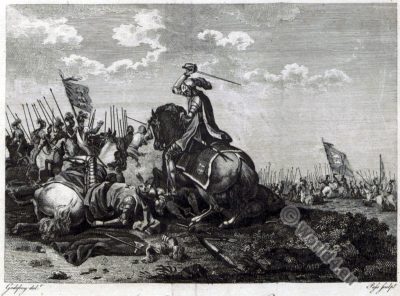
Source: A critical inquiry into antient armour: as it existed in Europe, but particularly in England, from the Norman conquest to the reign of King Charles II, with a glossary of military terms of the middle ages by Samuel Rush Meyrick. London: Printed for R. Jennings, sold by J. Gale, 1824.
Discover more from World4 Costume Culture History
Subscribe to get the latest posts sent to your email.



